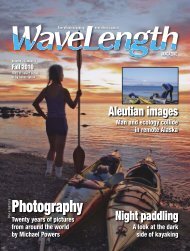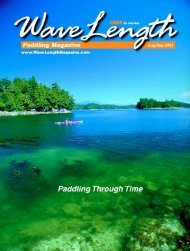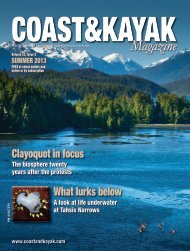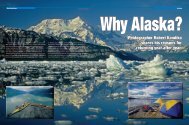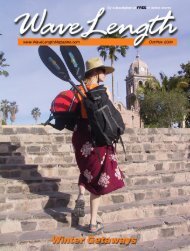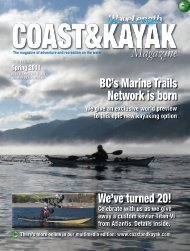Download - WaveLength Paddling Magazine
Download - WaveLength Paddling Magazine
Download - WaveLength Paddling Magazine
Create successful ePaper yourself
Turn your PDF publications into a flip-book with our unique Google optimized e-Paper software.
A Chile Winter<br />
There I am, taking those last few strokes<br />
in the calm rippled water, just seconds<br />
before outer serenity is equalized by inner<br />
rage–the point of no return above a gigantic<br />
rapid. As I reach the first massive reactionary,<br />
kicking hard towards the ugliness<br />
on the left, I realize where I am, realize that<br />
this is finally it—Zeta!<br />
But it couldn’t be. The water is too high,<br />
I’m way off line, and I can’t open my eyes!<br />
It’s a straightforward move and I have every<br />
intention of running it, but not today. Oh<br />
no! Can I pull it off? How did I get here?<br />
Am I here? Why am I so calm, so cozy?<br />
The rumble is so pervasive, so mesmerizing—it<br />
must be Zeta. But this feeling of<br />
sheer comfort, this softness all around me,<br />
a child’s voice in the distance, a cow bell<br />
ringing somewhere, confusion...<br />
“DESAYUNO!” Then it all comes together!<br />
The breakfast bells and the vitalizing<br />
surges of the Futaleufú River 100 metres<br />
away have woken me from another<br />
deep sleep. OK, so I didn’t run Zeta that<br />
morning, but I WILL!!<br />
Five days ago I was transported from my<br />
other existence: the never-ending race<br />
against deadlines, in the effort to maximize<br />
effectiveness and gain market share, to<br />
change the world. To be honest though, the<br />
transportation began months earlier when<br />
I sealed plans to leave the concrete world<br />
behind and disappear into the Patagonia<br />
Mountains of southern Chile.<br />
The journey took me past the 7,000 metre<br />
peaks that encircle Santiago, then<br />
1,100km further south to the harbor city of<br />
Puerto Montt. From there, I took a final<br />
sight-seeing flight along Chile’s southwestern<br />
coastline, where the meeting of mountains<br />
and ocean have left a remarkable<br />
scene of scattered islands, inlets and estuaries.<br />
After a last phone call home from the<br />
tiny ocean-side village of Chaiten, I was on<br />
my way up the Futaleufú Valley—into a<br />
world where electricity to the farms and<br />
homesteads has only become available over<br />
the past few years.<br />
Campo ‘Cara Del Indio’ is the base camp<br />
for Kayak Futaleufu, and is found about 8km<br />
up the 30km whitewater section of the Fu,<br />
on the land of the Torro-Mundaca family,<br />
who settled here many generations ago. The<br />
camp’s name derives from the natural etching<br />
of a native ‘Mapuche’ Chief’s face that<br />
watches over the land from across the river.<br />
The Toro-Mundaca family has worked<br />
hard to turn their land into a paddler's paradise,<br />
building private, riverside cabañas, a<br />
cedar-sauna and cliff-top jacuzzi, and serv-<br />
October/November 2002 www.<strong>WaveLength</strong><strong>Magazine</strong>.com<br />
Ken Whiting boofs the last part of<br />
Terminator rapid. (To ‘boof’ is to take a<br />
stroke off a waterfall so that you land flat,<br />
rather than penciling into the water below<br />
where you might hit your bow on rocks.)<br />
ing home-cooked Chilean meals designed<br />
for the hungry boater.<br />
Once settled into camp, I headed to the<br />
gear shed to choose the kayak that I would<br />
use for the week. The Fu is big water, but I<br />
was happy to learn that save for a few<br />
James McBeath<br />
‘toughies’, its non-technical, playful nature<br />
makes it great territory for play boats. Our<br />
first two days were spent warming up on<br />
some fun lower volume class 3 rivers. The<br />
Rio Espolon and the Rio Azul are both tributaries<br />
of the Fu that provide high quality<br />
play and breathtaking scenery. The Espolon<br />
runs alongside the remote village of<br />
Futaleufú and is a perfect river for working<br />
out any cobwebs. Our second day was<br />
spent on the Rio Azul, named after the surreal<br />
blue color of the water. The Azul was<br />
slightly steeper and more challenging than<br />
the Espolon, and it took us to some faster<br />
play waves and through two of the most<br />
stunning canyons imaginable. A day on the<br />
Azul also provides a perfect opportunity to<br />
get acquainted with the Fu, as the two different<br />
shades of azure coalesce just above<br />
a fun 3km section that has four progressively<br />
bigger rapids.<br />
Despite having two days to warm up, the<br />
sheer volume of the Fu made my heart<br />
pound fiercely, but I was ready! I cruised<br />
through the first few rapids with surprising<br />
ease and even found myself reaching a<br />
comfort level with the huge rollers and high<br />
speeds. It wasn’t long before I was actually<br />
calling the river on for more!<br />
Then came the grand finale of the day,<br />
‘Asleep at the Wheel’. This effectively<br />
quashed my newfound cockiness when an<br />
enormous exploding wave decided to crash<br />
on my head as I neared its crest. SLAM!<br />
But after a quick roll and a sweet roller-➞<br />
5




